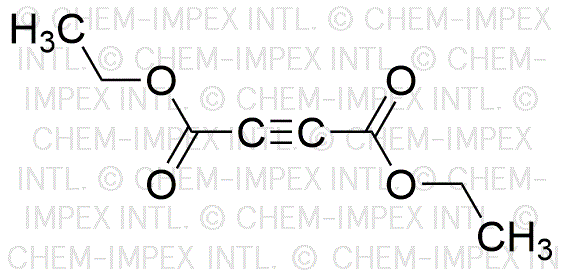Diethyl acetylenedicarboxylate is widely utilized in research focused on:
- Synthesis of Fine Chemicals: This compound serves as a versatile building block in organic synthesis, particularly in the production of fine chemicals and pharmaceuticals. Its unique structure allows for the formation of complex molecules through various reactions.
- Drug Development: In medicinal chemistry, it is used to create intermediates for drug candidates. Researchers leverage its reactivity to develop compounds that may lead to new therapeutic agents.
- Polymer Chemistry: It plays a crucial role in the synthesis of polymers and copolymers. The compound's ability to undergo polymerization reactions makes it valuable in creating materials with tailored properties for specific applications.
- Biochemical Research: This chemical is employed in the study of biochemical pathways and mechanisms. Its derivatives can be used to probe enzyme activity or to design inhibitors, aiding in the understanding of biological processes.
- Material Science: Diethyl acetylenedicarboxylate is used in the development of advanced materials, including coatings and adhesives. Its properties contribute to enhancing the performance and durability of these materials.
General Information
Properties
Safety and Regulations
Applications
Diethyl acetylenedicarboxylate is widely utilized in research focused on:
- Synthesis of Fine Chemicals: This compound serves as a versatile building block in organic synthesis, particularly in the production of fine chemicals and pharmaceuticals. Its unique structure allows for the formation of complex molecules through various reactions.
- Drug Development: In medicinal chemistry, it is used to create intermediates for drug candidates. Researchers leverage its reactivity to develop compounds that may lead to new therapeutic agents.
- Polymer Chemistry: It plays a crucial role in the synthesis of polymers and copolymers. The compound's ability to undergo polymerization reactions makes it valuable in creating materials with tailored properties for specific applications.
- Biochemical Research: This chemical is employed in the study of biochemical pathways and mechanisms. Its derivatives can be used to probe enzyme activity or to design inhibitors, aiding in the understanding of biological processes.
- Material Science: Diethyl acetylenedicarboxylate is used in the development of advanced materials, including coatings and adhesives. Its properties contribute to enhancing the performance and durability of these materials.
Documents
Safety Data Sheets (SDS)
The SDS provides comprehensive safety information on handling, storage, and disposal of the product.
Product Specification (PS)
The PS provides a comprehensive breakdown of the product’s properties, including chemical composition, physical state, purity, and storage requirements. It also details acceptable quality ranges and the product's intended applications.
Certificates of Analysis (COA)
Search for Certificates of Analysis (COA) by entering the products Lot Number. Lot and Batch Numbers can be found on a product’s label following the words ‘Lot’ or ‘Batch’.
*Catalog Number
*Lot Number
Certificates Of Origin (COO)
This COO confirms the country where the product was manufactured, and also details the materials and components used in it and whether it is derived from natural, synthetic, or other specific sources. This certificate may be required for customs, trade, and regulatory compliance.
*Catalog Number
*Lot Number
Safety Data Sheets (SDS)
The SDS provides comprehensive safety information on handling, storage, and disposal of the product.
DownloadProduct Specification (PS)
The PS provides a comprehensive breakdown of the product’s properties, including chemical composition, physical state, purity, and storage requirements. It also details acceptable quality ranges and the product's intended applications.
DownloadCertificates of Analysis (COA)
Search for Certificates of Analysis (COA) by entering the products Lot Number. Lot and Batch Numbers can be found on a product’s label following the words ‘Lot’ or ‘Batch’.
*Catalog Number
*Lot Number
Certificates Of Origin (COO)
This COO confirms the country where the product was manufactured, and also details the materials and components used in it and whether it is derived from natural, synthetic, or other specific sources. This certificate may be required for customs, trade, and regulatory compliance.


